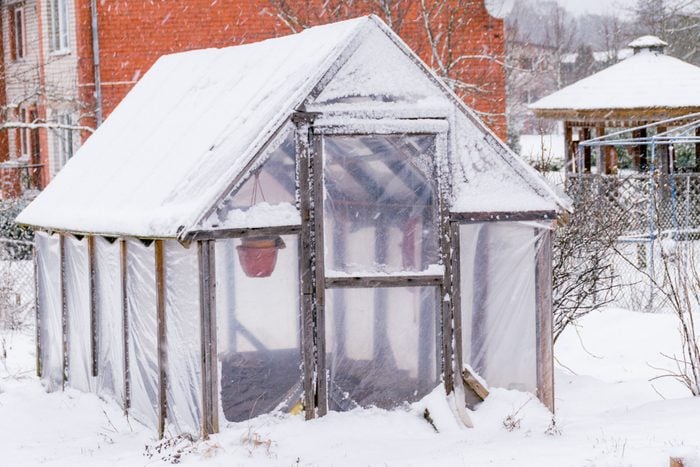What To Know About Prepping Your Greenhouse for the Winter
Updated: Feb. 29, 2024

If you own a greenhouse, take some steps to winterize it to avoid problems during colder weather.
If you’ve invested in a greenhouse to extend your growing season, it can be a magical place to spend some time on a wintry day. But if you haven’t properly prepared it for winter, it could be a nightmare.
I checked with several horticulturists and experienced gardeners lucky enough to own greenhouses to learn what steps they take to get theirs ready for cold weather.
On This Page
Wash the Windows
It’s surprising how much dirt can build up on a window during the summer. Imagine how much more dirt can accumulate on a roof made of glass or strong polycarbonate panels. All that dirt blocks light.
“If you can arrange to wash the outside and inside windows of your greenhouse on a warm day before temperatures dip too much, this improves light getting into your greenhouse,” says Donna Balzer, a horticulturist and garden consultant.
“I use a car-wash brush with soapy water to reach the top of my polycarbonate panels. Annual washing also dislodges any pests considering overwintering in my cozy space.”
Clean the Inside of the Greenhouse
If you stashed empty pots and containers in your greenhouse during the summer, clear them out. Dispose of or donate anything you don’t want, then sweep and clean off all the benches inside before bringing in any plants. Use a strong water spray to really clean the floors and benches.
Shut Off the Water Supply
Many gardeners run a water line out to their greenhouse, much like those for in-ground irrigation systems.
Doug Oster, host of The Organic Gardener Radio Show in Pittsburgh, Pennsylvania, owns an unheated greenhouse. He says his most important task before winter arrives involves shutting off the water and draining the lines so they don’t freeze and crack.
“Nothing worse than opening the greenhouse up in the spring to start seeds and have water spraying everywhere,” he says. “It happened to me once early on.”
Repair Any Cracked or Missing Glass
Oster also recommends inspecting all the glass or plastic panels of your greenhouse for cracks. Some panels may have even fallen out. Replace them or seal with a suitable caulk. Sealing up cracks should also keep out unwanted pests.
Decide if You’re Going to Heat Your Greenhouse
Some want-to-be greenhouse owners are surprised to discover many gardeners don’t heat their greenhouses in the winter, or provide only enough heat to keep some cold-tolerate plants alive.
“If they are keeping plants in their greenhouses for the winter, it is best to keep them off the ground and on tables,” says Denise Schreiber, Mrs. Know It All of The Organic Gardener Radio Show. “The heat should be kept at a minimum of 55 degrees but no higher than 62 degrees. Even though we like to be warm in the winter, the plants can tolerate colder temperatures than normal.”
If you do decide to heat your greenhouse, add a thermometer with an alarm to alert you if the temperature falls below a set level. This can help you avoid a disaster should your heat source fail.
Dee Nash, a greenhouse owner and garden coach, uses an outdoor thermometer with a wireless connection that displays the temperature on a panel indoors. She checks it daily.
Prepare for Snow Loads
If you live in an area that receives a decent amount of snow, be prepared to remove it from the roof of your greenhouse, especially if you don’t heat it during the winter.
“If there is a chance of heavy snow,” Schreiber says, “heating a greenhouse even to 50 degrees is enough to melt the snow and keep the greenhouse from collapsing under the weight of the snow.”
Set Your Expectations for What You Can Grow
I think one of the best places to be in a snowstorm is inside a tropical greenhouse conservatory. Your greenhouse won’t be quite the same, unless you’re ready to pay high prices for heating.
“It is possible, even in cold climates, to continue `growing’ greens, but unfortunately most things don’t really grow once day length is below 10 hours a day,” Balzer says. “Greenhouse growing does offer a real head start, though. Because once day length is over 10 hours, cold crops, like spinach, will start growing again.”
Oster concurs, noting his unheated greenhouse can reach temperatures as high as 80 degrees on a sunny February day no matter the outdoor temperature. “It’s a great place to sit and read garden catalogs, dreaming of spring planting,” he says.
About The Experts
Donna Balzer is a horticulturist a garden consultant based in Canada. Her motto: “I help gardeners grow and beginners blossom.”
Doug Oster, based in Pittsburgh, Pennsylvania, is the host of The Organic Gardener Radio Show on KDKA-AM and In Doug’s Garden on YouTube. He’s also written two gardening books and numerous articles.
Denise Schreiber is a retired certified arborist and author known as Mrs. Know It All on The Organic Gardener Radio Show.
Dee Nash is a garden coach and podcaster based in Oklahoma. She frequently contributes how-to videos on Instagram.
